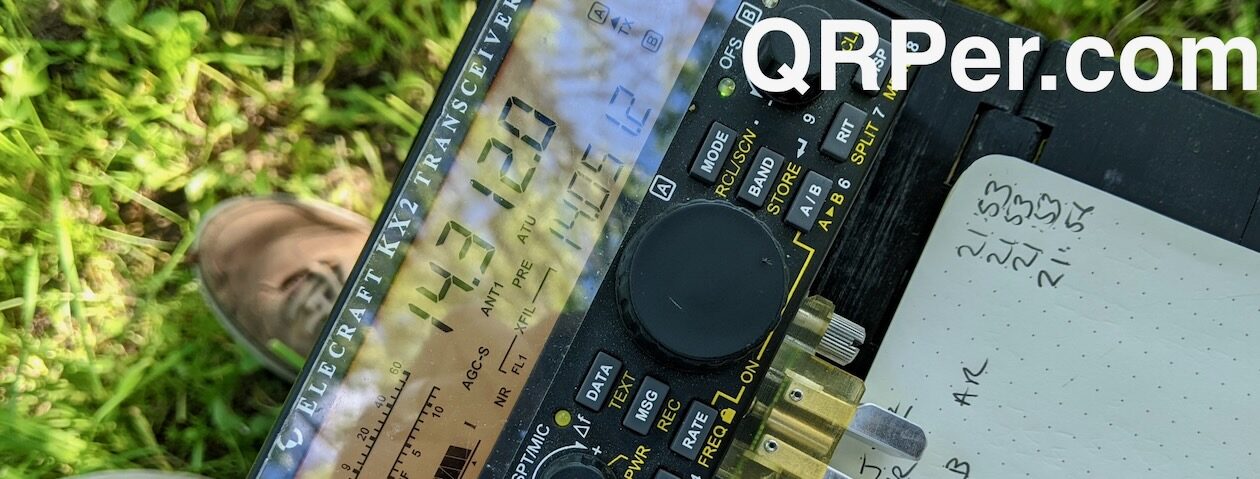On the morning of Wednesday, May 15, 2024, I woke up, grabbed breakfast, and headed to Strouds Run State Park in Athens, Ohio. (You can read about that activation in my previous field report.)
 Once I returned to Eric’s (WD8RIF) QTH, Eric, his son Miles (KD8KNC), and I packed up the car for the drive to Dayton—roughly 2.5 hours from Athens. En route, we decided on an activation of Scioto Trail State Park (US-1990) which also happens to be a two-fer with Scioto Trail State Forest (US-5448).
Once I returned to Eric’s (WD8RIF) QTH, Eric, his son Miles (KD8KNC), and I packed up the car for the drive to Dayton—roughly 2.5 hours from Athens. En route, we decided on an activation of Scioto Trail State Park (US-1990) which also happens to be a two-fer with Scioto Trail State Forest (US-5448).
I’d hoped band conditions would remain as favorable as they were in the morning, but the sun had other plans! (Indeed, this would become a recurring theme throughout the following week.)
Scioto Trail State Park (US-1990) and Forest (US-5448)
 We arrived at Scioto Trail around 2:00 PM, under scattered clouds and after passing through some rain. We hoped the weather would hold!
We arrived at Scioto Trail around 2:00 PM, under scattered clouds and after passing through some rain. We hoped the weather would hold!



 I’d never been to Scioto before and was pleased to see a small island on the lake accessible by a footbridge. It had a gazebo, perfect for a POTA station.
I’d never been to Scioto before and was pleased to see a small island on the lake accessible by a footbridge. It had a gazebo, perfect for a POTA station.
Reunited
 A highlight of this trip was giving Eric a chance to operate my Index Labs QRP Plus. Eric had owned one for 13 years as his first field radio. In fact, as I’ve mentioned before, when I first met Eric in 1997, it was while he was operating a QRP Plus during FYBO!
A highlight of this trip was giving Eric a chance to operate my Index Labs QRP Plus. Eric had owned one for 13 years as his first field radio. In fact, as I’ve mentioned before, when I first met Eric in 1997, it was while he was operating a QRP Plus during FYBO!
Since the QRP Plus is better suited for tabletop use, I recommended Eric set up in the gazebo.
 I provided my Chelegance MC-750 for him to operate on 20M.
I provided my Chelegance MC-750 for him to operate on 20M.
POTA in the Shade
 I set up under a tree at the edge of the island—as far from Eric as possible to minimize interference. In reality, the island is small, so I was only about 15 meters away—not ideal!
I set up under a tree at the edge of the island—as far from Eric as possible to minimize interference. In reality, the island is small, so I was only about 15 meters away—not ideal!
 The tree offered some shade and potential rain protection. I deployed my Helinox Chair, my “no-transformer, no feedline” Tufteln random wire antenna, the Elecraft KX2, and my Tufteln/N0RNM kneeboard.
The tree offered some shade and potential rain protection. I deployed my Helinox Chair, my “no-transformer, no feedline” Tufteln random wire antenna, the Elecraft KX2, and my Tufteln/N0RNM kneeboard.
 When I turned on the radio, I could hear Eric’s signal bleeding through on 30 meters (a band I chose to avoid harmonic interference with 20M).
When I turned on the radio, I could hear Eric’s signal bleeding through on 30 meters (a band I chose to avoid harmonic interference with 20M).
 The KX2 is sensitive, so this wasn’t unexpected. Eric never experienced interference from my station, likely due to the QRP Plus’s less sensitive receiver.
The KX2 is sensitive, so this wasn’t unexpected. Eric never experienced interference from my station, likely due to the QRP Plus’s less sensitive receiver.
Gear:
 Note: All Amazon, CW Morse, ABR, Chelegance, eBay, and Radioddity links are affiliate links that support QRPer.com at no cost to you.
Note: All Amazon, CW Morse, ABR, Chelegance, eBay, and Radioddity links are affiliate links that support QRPer.com at no cost to you.
-
- Elecraft KX2 with Windcamp X2 Side Rails
- Tufteln KX2 Protective Cover
- KXPD2 Paddles
- Elecraft KXBT2 Li-Ion Battery Pack
- LowePro CS60 Hard Side Case
- Tufteln Portable EFRW No Transformer QRP Antenna
- Tufteln N0RNM Folding Knee Board
- GoRuck GR1 USA
- Weaver arborist throw line/weight and storage bag
- GraphGear 0.9mm 1000 Automatic Drafting Pencil
- Rite In The Rain Top Spiral Notebook
- Camera: DJI OSMO 4 action camera with Joby Telepod Sport Tripod
- DJI Wireless Microphones
- Helinox Chair Zero
On the air
 This turned out to be an activation where I’d really put my KX2 ATU to work! Continue reading Overcoming Band Conditions: A Challenging (But Rewarding) POTA Activation at Scioto Trail State Park!
This turned out to be an activation where I’d really put my KX2 ATU to work! Continue reading Overcoming Band Conditions: A Challenging (But Rewarding) POTA Activation at Scioto Trail State Park!











































